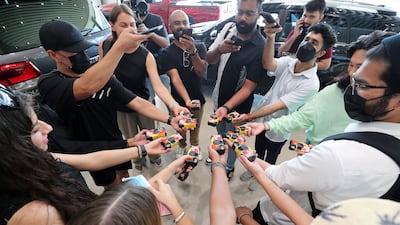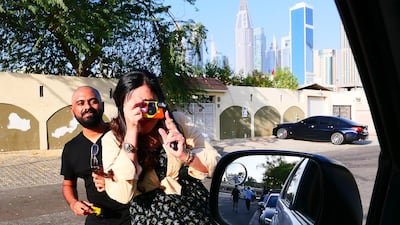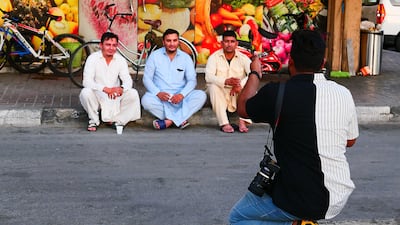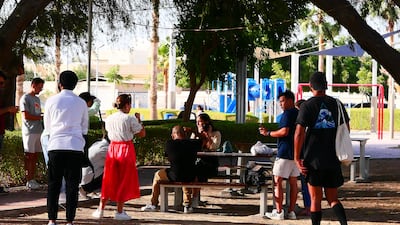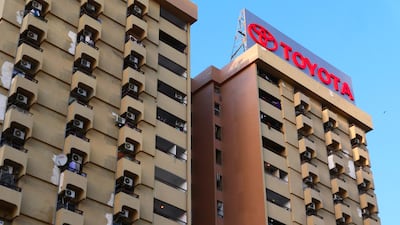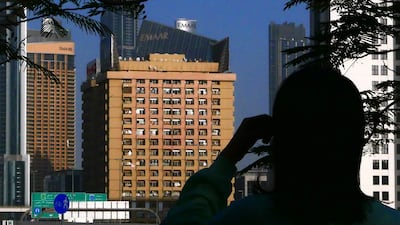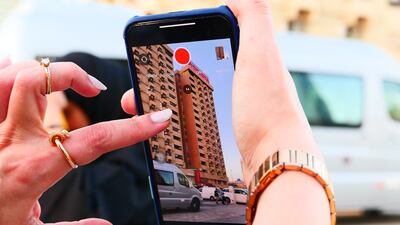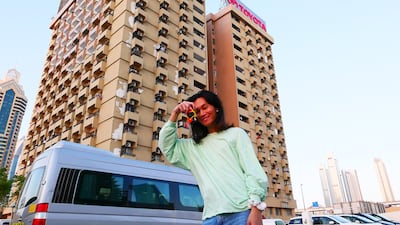In an era before Burj Khalifa, there were two landmarks to tell you you had arrived in Dubai. One was the World Trade Centre and the other was the Toyota Building.
Named so because of its neon sign, the Toyota Building served as a reference point as the city expanded. In 2018, the sign disappeared.
The two-block residential tower is properly known as the Nasser Rashid Lootah Building and its owners, the NRL Group, told The National that the advertising contract with Toyota was renewed recently.
“The contract ended several years ago but it has started again,” the group said.
The English sign was restored to the side of the building that greets drivers heading north towards Sharjah, while an Arabic sign has been installed on the opposite side.
Al Futtaim Toyota also said on Monday the sign was back “by popular demand” following a survey.
There is a lot of nostalgia and fond memories that Dubai residents associate with the billboard. Bringing it back is our tribute to the spirit of Dubai
Vincent Wijnen,
senior managing director, Al Futtaim Automotive
“There is a lot of nostalgia and fond memories that Dubai residents associate with the billboard,” said Vincent Wijnen, senior managing director at Al Futtaim Automotive. “Bringing it back is our tribute to the spirit of Dubai.”
The significance of the Lootah tower, however, goes far beyond a simple sign, and, like all old buildings in Dubai, it has a story to tell.
It appeared on the city’s skyline at some point in the late 1970s. Archive photographs taken by Gulf News photographers from the World Trade Centre in 1979 show it close to completion.
It was one of the few high-rises in Dubai then, surrounded by nothing but sand, beside what was known as Defence Roundabout. All Futtaim Toyota said the sign was installed in the 1980s but neon was not new in Dubai.
“Neon signage had … already lit up the night sky for nearly two decades from on top of buildings along Dubai Creek,” said Todd Reisz, author of Showpiece City: How Architecture Made Dubai.
Rather than the sign, Mr Reisz said the building’s significance lies more in representing a new phase in Dubai’s expansion.
“The Toyota signage and the building below it were part of a ramped-up campaign to stretch the city beyond the Creek, towards the city’s developing new ports,” said Mr Reisz, referring to Port Rashid, Dubai Drydocks and Jebel Ali Port.
“Probably completed in the late 1970s or early 1980s just after the World Trade Centre, the Lootah building helped to configure the Abu Dhabi road, not yet known as Sheikh Zayed Road, as the city’s spine.”
The building reflects its era. Its concrete, shaded balconies and smaller windows offered residents respite from the searing heat.
Over the years, however, the tower has been overshadowed by modern skyscrapers, including the world's tallest building, Burj Khalifa.
Its once white exterior has been painted brown but older external air conditioning units still dot the exterior. On the ground floor are some small shops including a grocery, laundry and restaurant. A rudimentary street gym has closed, with locks on the door and faded posters of musclemen yellowing on the walls.
That the building remains is a statement in itself and many residents still call it home. The NRL Group said it plans a maintenance programme soon.
Yasser Elsheshtawy, adjunct professor of architecture at Columbia University in the US and expert on urbanism in the Gulf, cautioned against getting too nostalgic about such buildings as there are times when people need to step back and look at what the city needs.
“It is natural to think fondly of some of these buildings and associate some romantic idea of the ‘good old times’ and sense of community,” he said. “But this could be wishful thinking and not truly what existed at the time.
“The danger is that nostalgia is attached to these buildings. I personally don’t think much would be lost if it were to be demolished. People who live there need to be relocated and given appropriate housing. It could be a park and provide an open air space for people in that area.”
The privately-owned tower and wider neighbourhood have been the subject of a recent photographic tour run by Dubai’s Gulf Photo Plus that examined the area’s history and urban development.
“Toyota have done a great service to the participants and residents by highlighting this local icon,” said Gulf Photo Plus’s Raz Hansrod.
“And [by] using the opportunity of the sign reinstatement to share cultural insights with participants and the wider community,” said Mr Hansrod, who said Toyota had contacted them about a tour and they worked together to place the building in a historic context.
This tour also reflects the surge of interest in the UAE’s architectural heritage over the past few years, including Mr Reisz’s and Prof Elsheshtawy's work.
Sultan Sooud Al Qassemi and Mr Reisz also co-edited Building Sharjah, a book which documented modernist architecture in the emirate. Sharjah Art Foundation has restored buildings such as the Flying Saucer, while the Sharjah Architecture Triennial holds walking tours of historic neighbourhoods.
In Abu Dhabi, a modern heritage initiative aims to safeguard its historic architecture, while in 2018 Dubai Municipality launched one of its own.
But questions will always swirl about redevelopment when it comes to these buildings.
“There have been multiple rumours about pending demolition,” Mr Reisz said.
“That’s not surprising considering that it is clearly of another era and now in the midst of a new district targeting an income level beyond that of current residents. The building once announced Dubai’s economic advancement. Today, it survives as a hope for a more demographically integrated Dubai.”
Dubai's development through the years — in pictures
The specs: 2018 Jaguar F-Type Convertible
Price, base / as tested: Dh283,080 / Dh318,465
Engine: 2.0-litre inline four-cylinder
Transmission: Eight-speed automatic
Power: 295hp @ 5,500rpm
Torque: 400Nm @ 1,500rpm
Fuel economy, combined: 7.2L / 100km
Killing of Qassem Suleimani
Wicked: For Good
Director: Jon M Chu
Starring: Ariana Grande, Cynthia Erivo, Jonathan Bailey, Jeff Goldblum, Michelle Yeoh, Ethan Slater
Rating: 4/5
Tamkeen's offering
- Option 1: 70% in year 1, 50% in year 2, 30% in year 3
- Option 2: 50% across three years
- Option 3: 30% across five years
UAE currency: the story behind the money in your pockets
Story%20behind%20the%20UAE%20flag
%3Cp%3EThe%20UAE%20flag%20was%20first%20unveiled%20on%20December%202%2C%201971%2C%20the%20day%20the%20UAE%20was%20formed.%C2%A0%3C%2Fp%3E%0A%3Cp%3EIt%20was%20designed%20by%20Abdullah%20Mohammed%20Al%20Maainah%2C%2019%2C%20an%20Emirati%20from%20Abu%20Dhabi.%C2%A0%3C%2Fp%3E%0A%3Cp%3EMr%20Al%20Maainah%20said%20in%20an%20interview%20with%20%3Cem%3EThe%20National%3C%2Fem%3E%20in%202011%20he%20chose%20the%20colours%20for%20local%20reasons.%C2%A0%3C%2Fp%3E%0A%3Cp%3EThe%20black%20represents%20the%20oil%20riches%20that%20transformed%20the%20UAE%2C%20green%20stands%20for%20fertility%20and%20the%20red%20and%20white%20colours%20were%20drawn%20from%20those%20found%20in%20existing%20emirate%20flags.%3C%2Fp%3E%0A
French business
France has organised a delegation of leading businesses to travel to Syria. The group was led by French shipping giant CMA CGM, which struck a 30-year contract in May with the Syrian government to develop and run Latakia port. Also present were water and waste management company Suez, defence multinational Thales, and Ellipse Group, which is currently looking into rehabilitating Syrian hospitals.
Dirham Stretcher tips for having a baby in the UAE
Selma Abdelhamid, the group's moderator, offers her guide to guide the cost of having a young family:
• Buy second hand stuff
They grow so fast. Don't get a second hand car seat though, unless you 100 per cent know it's not expired and hasn't been in an accident.
• Get a health card and vaccinate your child for free at government health centres
Ms Ma says she discovered this after spending thousands on vaccinations at private clinics.
• Join mum and baby coffee mornings provided by clinics, babysitting companies or nurseries.
Before joining baby classes ask for a free trial session. This way you will know if it's for you or not. You'll be surprised how great some classes are and how bad others are.
• Once baby is ready for solids, cook at home
Take the food with you in reusable pouches or jars. You'll save a fortune and you'll know exactly what you're feeding your child.
8 traditional Jamaican dishes to try at Kingston 21
- Trench Town Rock: Jamaican-style curry goat served in a pastry basket with a carrot and potato garnish
- Rock Steady Jerk Chicken: chicken marinated for 24 hours and slow-cooked on the grill
- Mento Oxtail: flavoured oxtail stewed for five hours with herbs
- Ackee and salt fish: the national dish of Jamaica makes for a hearty breakfast
- Jamaican porridge: another breakfast favourite, can be made with peanut, cornmeal, banana and plantain
- Jamaican beef patty: a pastry with ground beef filling
- Hellshire Pon di Beach: Fresh fish with pickles
- Out of Many: traditional sweet potato pudding
The biog
Favourite films: Casablanca and Lawrence of Arabia
Favourite books: Start with Why by Simon Sinek and Good to be Great by Jim Collins
Favourite dish: Grilled fish
Inspiration: Sheikh Zayed's visionary leadership taught me to embrace new challenges.
Zakat definitions
Zakat: an Arabic word meaning ‘to cleanse’ or ‘purification’.
Nisab: the minimum amount that a Muslim must have before being obliged to pay zakat. Traditionally, the nisab threshold was 87.48 grams of gold, or 612.36 grams of silver. The monetary value of the nisab therefore varies by current prices and currencies.
Zakat Al Mal: the ‘cleansing’ of wealth, as one of the five pillars of Islam; a spiritual duty for all Muslims meeting the ‘nisab’ wealth criteria in a lunar year, to pay 2.5 per cent of their wealth in alms to the deserving and needy.
Zakat Al Fitr: a donation to charity given during Ramadan, before Eid Al Fitr, in the form of food. Every adult Muslim who possesses food in excess of the needs of themselves and their family must pay two qadahs (an old measure just over 2 kilograms) of flour, wheat, barley or rice from each person in a household, as a minimum.
Living in...
This article is part of a guide on where to live in the UAE. Our reporters will profile some of the country’s most desirable districts, provide an estimate of rental prices and introduce you to some of the residents who call each area home.
The specs
Price, base / as tested Dh135,000
Engine 1.6L turbo
Gearbox Six speed automatic with manual and sports mode
Power 165hp @ 6,000rpm
Torque 240Nm @ 1,400rpm 0-100kph: 9.2 seconds
Top speed 420 kph (governed)
Fuel economy, combined 35.2L / 100km (est)
Race card:
6.30pm: Baniyas (PA) Group 2 Dh195,000 1,400m.
7.05pm: Maiden (TB) Dh165,000 1,400m.
7.40pm: Handicap (TB) Dh190,000 1,200m.
8.15pm: Maiden (TB) Dh165,000 1,200m.
8.50pm: Rated Conditions (TB) Dh240,000 1,600m.
9.20pm: Handicap (TB) Dh165,000 1,400m.
10pm: Handicap (TB) Dh175,000 2,000m.
Scores in brief:
Day 1
New Zealand (1st innings) 153 all out (66.3 overs) - Williamson 63, Nicholls 28, Yasir 3-54, Haris 2-11, Abbas 2-13, Hasan 2-38
Pakistan (1st innings) 59-2 (23 overs)
10 tips for entry-level job seekers
- Have an up-to-date, professional LinkedIn profile. If you don’t have a LinkedIn account, set one up today. Avoid poor-quality profile pictures with distracting backgrounds. Include a professional summary and begin to grow your network.
- Keep track of the job trends in your sector through the news. Apply for job alerts at your dream organisations and the types of jobs you want – LinkedIn uses AI to share similar relevant jobs based on your selections.
- Double check that you’ve highlighted relevant skills on your resume and LinkedIn profile.
- For most entry-level jobs, your resume will first be filtered by an applicant tracking system for keywords. Look closely at the description of the job you are applying for and mirror the language as much as possible (while being honest and accurate about your skills and experience).
- Keep your CV professional and in a simple format – make sure you tailor your cover letter and application to the company and role.
- Go online and look for details on job specifications for your target position. Make a list of skills required and set yourself some learning goals to tick off all the necessary skills one by one.
- Don’t be afraid to reach outside your immediate friends and family to other acquaintances and let them know you are looking for new opportunities.
- Make sure you’ve set your LinkedIn profile to signal that you are “open to opportunities”. Also be sure to use LinkedIn to search for people who are still actively hiring by searching for those that have the headline “I’m hiring” or “We’re hiring” in their profile.
- Prepare for online interviews using mock interview tools. Even before landing interviews, it can be useful to start practising.
- Be professional and patient. Always be professional with whoever you are interacting with throughout your search process, this will be remembered. You need to be patient, dedicated and not give up on your search. Candidates need to make sure they are following up appropriately for roles they have applied.
Arda Atalay, head of Mena private sector at LinkedIn Talent Solutions, Rudy Bier, managing partner of Kinetic Business Solutions and Ben Kinerman Daltrey, co-founder of KinFitz
MATCH INFO
Uefa Champions League, semi-final result:
Liverpool 4-0 Barcelona
Liverpool win 4-3 on aggregate
Champions Legaue final: June 1, Madrid
The specs
Price, base / as tested Dh1,100,000 (est)
Engine 5.2-litre V10
Gearbox seven-speed dual clutch
Power 630bhp @ 8,000rpm
Torque 600Nm @ 6,500rpm
Fuel economy, combined 15.7L / 100km (est)
WITHIN%20SAND
%3Cp%3EDirector%3A%20Moe%20Alatawi%3C%2Fp%3E%0A%3Cp%3EStarring%3A%20Ra%E2%80%99ed%20Alshammari%2C%20Adwa%20Fahd%2C%20Muhand%20Alsaleh%3C%2Fp%3E%0A%3Cp%3ERating%3A%203%2F5%3C%2Fp%3E%0A
The specs
Engine: 2.0-litre 4cyl turbo
Power: 261hp at 5,500rpm
Torque: 405Nm at 1,750-3,500rpm
Transmission: 9-speed auto
Fuel consumption: 6.9L/100km
On sale: Now
Price: From Dh117,059
Dolittle
Director: Stephen Gaghan
Stars: Robert Downey Jr, Michael Sheen
One-and-a-half out of five stars
Sour%20Grapes
%3Cp%3E%3Cstrong%3EAuthor%3A%20%3C%2Fstrong%3EZakaria%20Tamer%3Cbr%3E%3Cstrong%3EPublisher%3A%20%3C%2Fstrong%3ESyracuse%20University%20Press%3Cbr%3E%3Cstrong%3EPages%3A%20%3C%2Fstrong%3E176%3C%2Fp%3E%0A
THE BIO
Favourite author - Paulo Coelho
Favourite holiday destination - Cuba
New York Times or Jordan Times? NYT is a school and JT was my practice field
Role model - My Grandfather
Dream interviewee - Che Guevara
The specs: 2018 Bentley Bentayga V8
Price, base: Dh853,226
Engine: 4.0-litre twin-turbo V8
Transmission: Eight-speed automatic
Power: 550hp @ 6,000pm
Torque: 770Nm @ 1,960rpm
Fuel economy, combined: 11.4L / 100km
All%20The%20Light%20We%20Cannot%20See%20
%3Cp%3E%3Cstrong%3ECreator%3A%20%3C%2Fstrong%3ESteven%20Knight%3C%2Fp%3E%0A%3Cp%3E%3Cstrong%3EStars%3A%C2%A0%3C%2Fstrong%3EMark%20Ruffalo%2C%20Hugh%20Laurie%2C%20Aria%20Mia%20Loberti%3C%2Fp%3E%0A%3Cp%3E%3Cstrong%3ERating%3A%20%3C%2Fstrong%3E1%2F5%C2%A0%3C%2Fp%3E%0A
MATCH INFO
Euro 2020 qualifier
Russia v Scotland, Thursday, 10.45pm (UAE)
TV: Match on BeIN Sports
UAE currency: the story behind the money in your pockets
Real estate tokenisation project
Dubai launched the pilot phase of its real estate tokenisation project last month.
The initiative focuses on converting real estate assets into digital tokens recorded on blockchain technology and helps in streamlining the process of buying, selling and investing, the Dubai Land Department said.
Dubai’s real estate tokenisation market is projected to reach Dh60 billion ($16.33 billion) by 2033, representing 7 per cent of the emirate’s total property transactions, according to the DLD.
Sholto Byrnes on Myanmar politics
